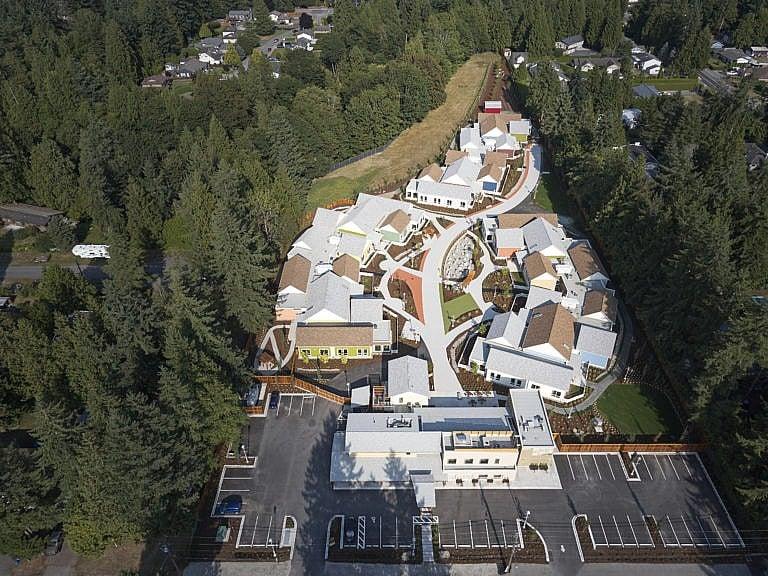Retirement communities across Canada are going all in on holistic wellness
For these Canadian retirement homes, physical and mental health comes first for its residents.

The Village Langley, a dementia living community
Share
The reputation of long-term care homes has taken a beating in the pandemic years. Due to mismanagement, a lack of preparation, understaffing and an assortment of other woes, many long-term care homes have become hotbeds for Covid-19 outbreaks, a revelation that has provoked deeper questions about the quality of care provided to our seniors. It’s become clear that many have failed to meet the emotional and even physical needs of the people who rely on them.
But some long-term care homes are trying to do things a bit differently—they’re taking a wellness-first approach for their residents through unique amenities and programs designed to spark late-life joy.
One such retirement home is Tapestry at Village Gate West. Tapestry is an emerging retirement organization that operates four communities across Canada—three in British Columbia and one in Toronto. Village Gate West is located in Etobicoke in Toronto’s west end and is oriented around “seven dimensions of wellness”: physical, emotional, intellectual, social, spiritual, environmental and occupational. For starters, residents enjoy a full-service salon and spa, a high-definition golf simulator, a theatre and a creative arts centre.
“We look at wellness very holistically,” says Adena Waffle, the vice-president of Tapestry. “Our goal in all of this is to help people live happier, healthier, longer lives, and to do that we have to engage our residents.”
Residents at Village Gate West have access to a bistro, a pub and an upscale restaurant, all located on site. They’re given $450 in credit to spend at these eateries every month, and can choose from full menus. “Retirement housing itself is about providing people with choice,” says Waffle. “So we don’t prescribe when or what people should be eating.”
That kind of freedom is an essential, and it’s something that many long-term care facilities lack, says Pat Armstrong, a professor of sociology at York University whose research focuses on improving long-term residential care in Canada. “If what you eat is contracted out and it comes down on a train, you won’t eat it because none of it looks very appetizing,” says Armstrong. “If it’s cooked on the premises so you can smell it, and if you have some choices about what to eat, that’s really critical.”

Tapestry recently received a monumental nod: the International Council of Aging gave all four of its retirement homes the Beacon Best in Wellness Award, which is doled out annually to the 25 North American retirement residences that best embrace wellness as a way of life. An important aspect of the positive culture at Tapestry homes, says Waffle, is making sure that residents are physically able to use the facilities. One way this is accomplished is by providing on-site kinesiology. “We have a resident who participated in the EdgeWalk at the CN Tower with us,” says Waffle. “When she first moved into Tapestry, she required more care than she wanted. And by working with our kinesiologists and our food and beverage team, she no longer required a mobility aid, and she could take that walk with us around the CN Tower.”
But wellness might not look like that for many other seniors. Verve Senior Living operates and develops retirement communities across the country, but its crown jewel is the Village, an innovative community for residents with dementia and other cognitive changes. It’s a sprawling seven-acre property located on former high school grounds in Langley, B.C.
The Village is exactly what it sounds like. The community looks and feels just like a real village, complete with its own fully stocked general store and post office. Residents live in 12-person households, each of which has a permanent staff of caregivers, allowing for personalized care and a smaller community of people within the larger Village.
For Armstrong, this kind of small-scale, community-oriented living is essential to providing humane, compassionate care, particularly for residents with cognitive differences. “We’ve seen a lot of places in Canada where residents are not allowed to make tea because they’re really afraid someone’s going to burn themselves,” says Armstrong. “If you have enough staff and you know your people well enough, you know that Mr. Jones is quite capable of making his own tea.”
Making sure carers aren’t infantilizing or neglecting their residents, adds Armstrong, requires effort, but it’s worth the added resources. It’s all part of what Scott Quinney, Verve’s vice-president of operations for Western Canada, calls enriched living. “It’s all about having the right environment and enabling residents to thrive within their environment,” says Quinney. The design of the Village allows residents to safely enjoy mobility, freedom and outdoor time. Each resident is given an electronic wristband that helps caretakers keep track of them. They also tell caretakers if residents have fallen over. The wristbands and the village’s roads are colour-coded so residents can easily find their way home.
That crucial element of choice is also present in the Village. Residents can choose how to spend their days—there’s a woodshop, paint classes, yoga and fitness sessions, and a community garden where residents can enjoy life together. All the amenities and services in the Village are adapted and customized to fit each resident’s wants and needs.
“It’s really important to learn about people’s lives and what is meaningful to them,” says Quinney. “We can really look to their past to help them continue to live in a fulfilling way.”